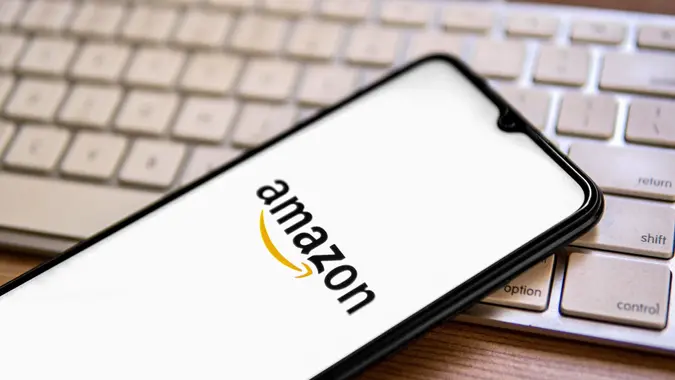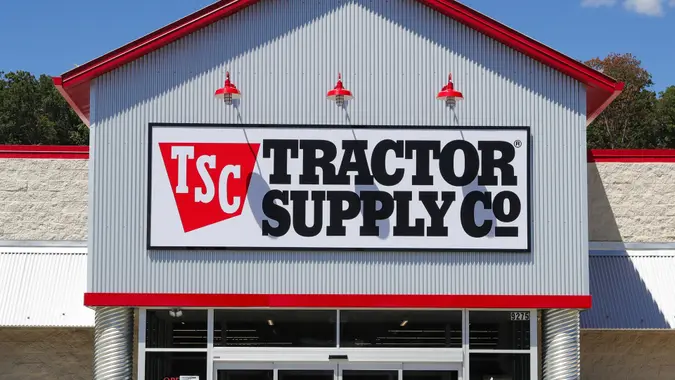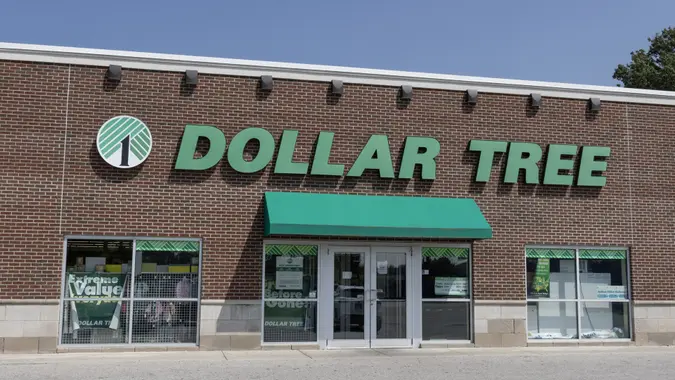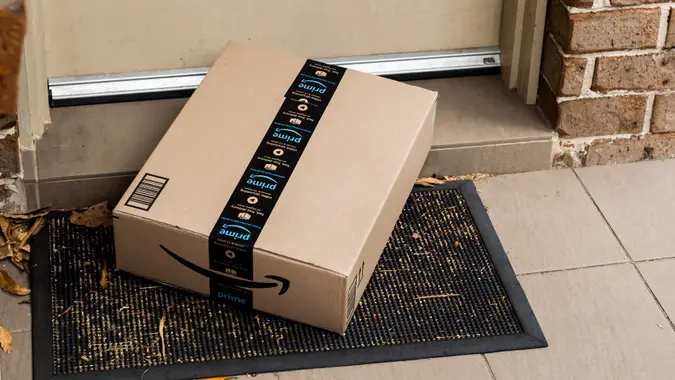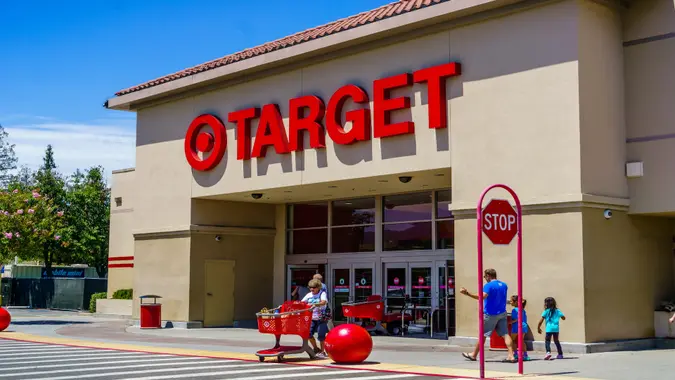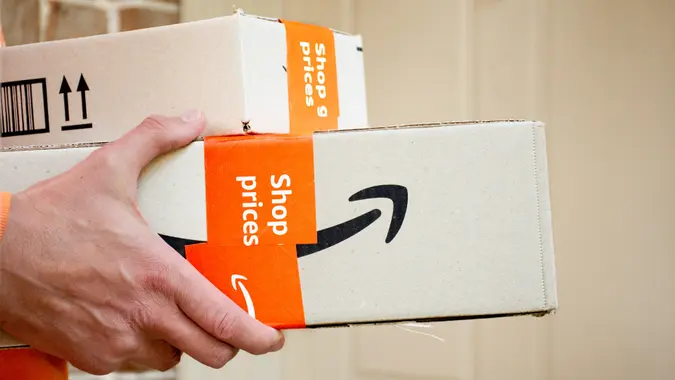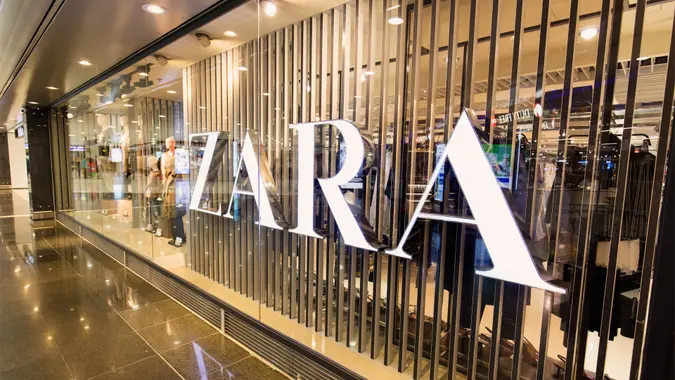7 Reasons To Limit Your Amazon Prime Day Spending to $100

Commitment to Our Readers
GOBankingRates' editorial team is committed to bringing you unbiased reviews and information. We use data-driven methodologies to evaluate financial products and services - our reviews and ratings are not influenced by advertisers. You can read more about our editorial guidelines and our products and services review methodology.

20 Years
Helping You Live Richer

Reviewed
by Experts

Trusted by
Millions of Readers
Amazon Prime Day takes place July 16 and 17 this year and is expected to be a huge sales event — even bigger than in previous years.
According to a recent RetailMeNot survey of over 1,200 American consumers, 81% of respondents plan to shop on Amazon Prime Day this year. The average consumer also plans to spend around $300 on Prime Day deals — twice the amount they spent last year.
Whether you’re already shopping those early deals or you’re waiting for the main event, you might want to keep a close eye on your finances this year. If you can, you might even want to keep your spending to a maximum of $100.
Why? Here’s what the expert say.
Overspending Is a Big Concern
You might not be thinking about your budget, what with all the excitement of those Prime Day deals, but you should be.
“Prime Day is a day that many consumers look forward to, because it’s one of Amazon’s biggest sales. In some cases, it can be the time to get a big-ticket item you’ve saved up for, or get a small gift for half the cost. However, overspending can really hurt your budget,” said Scott Lieberman, founder of Touchdown Money.
“Unless you’ve saved up for one big thing, going crazy on Prime Day can tank your budget,” he continued. “Prime Day isn’t so great when the bill comes due, if you can’t cover it.”
Not Everything Is a Deal
Deals aren’t always deals, even when they first appear to be. The next time you go on Amazon’s website, make sure you’re actually getting great deals on things you need.
“Just because Amazon says it’s a discount doesn’t mean it was,” said Lieberman. “Some [deals] are always priced low; it’s up to you to check if it’s really a good deal before you buy.”
Check how much the item you’re looking at costs now versus how much it originally cost. Then, compare both amounts with similar items at different retailers to ensure you’re actually saving money.
You Have Other Expenses
Deals or not, chances are you have other financial responsibilities. You might be able to spend $100 without breaking the bank, but it’s also wise to keep spending to a minimum, just in case you need that cash for something else — like an emergency or required expense.
When you do shop this year, make sure you have a clear plan and purpose for your spending — regardless of your budgeted amount.
“Planning is crucial, because Amazon Prime Day isn’t just a sale; it’s a celebratory event. People talk about it. There’s a buzz around it. Events and celebrations are places one might get caught up in the hoopla, so planning is needed,” said Michele Paiva, finance therapist at The Finance Therapist.
With sales and discounts everywhere you look, it’s way too easy to get tempted into spending money you maybe shouldn’t have. That’s where shopping with a purpose comes in.
“Choose a purpose first. The purpose is why you are even participating. Don’t just scroll and find deals. Instead, have a clear budget. Christmas or other holiday shopping is a good idea. Back-to-school shopping is around the corner, too,” Paiva said. “Find your purpose, and that’s your starting point.
“Now, whatever your purpose is — let’s say it is Christmas — take a fraction of what you might spend then and budget that for Amazon Prime Day. But again, don’t just scroll. Have a mission and write it down.”
Interest Charges Can Cut Into Savings
You might have a spare $100 for online shopping, but if you spend much more than that and have to rely on credit, you now have interest to worry about. If you don’t pay off your full balance before interest starts to accrue, any savings from those great deals can quickly dwindle away.
This won’t necessarily be an issue if you’ve set aside money specifically for Prime Day or if you have some extra cash. But if credit cards are in your future, keep your shopping to a minimum — or even skip the event altogether.
“Avoid using credit cards if you don’t have the cash to pay them off in full at the end of the month. Also, consider keeping just one credit card, for emergency use only,” said Darius Kingsley, managing director and head of consumer banking practices at Chase Bank. “Then, shred the others so you won’t be tempted to use them; but do not close the accounts, as that could negatively impact your credit score.”
It Limits Impulse Spending
Like any other major sales event, Prime Day encourages impulse shopping.
“[Prime Day] has all the elements of a celebration or event. It also has scarcity, which is a marketing tactic,” said Paiva.
By keeping your budget to $100, you’re less likely to be taken in by these marketing tactics and more likely to get what you actually need or want. Setting a budget might not be easy, but there are a few ways to make it happen.
“If it is hard for you to adhere to a budget, gamify it in your mind; make it a fun challenge to come out of the experience with money you haven’t spent,” Paiva said. “Before Prime Day, create your list. Set alerts by using Amazon’s Wish List and track prices. Leverage cash back credit rewards — on credit cards you responsibly manage — as many include Amazon. Before you hit ‘buy,’ assess if this is really what you want to purchase.”
It Might Be Better To Spread Out Purchases
You can find quite a few seasonal deals on Prime Day, as well as gifts for the upcoming winter holidays. But if you’re shopping for those kinds of deals, it might be better to spread out your spending.
According to a 2023 Gallup poll, the average American consumer spent an estimated $975 for Christmas and other holiday gifts last year. That’s quite a lot if you’re already strapped for cash or trying to keep cost low.
“I see Amazon Prime Day as a strategic way to benefit holiday shopping. It can help reduce the financial burden often experienced during holidays and helps the individual be more empowered,” said Paiva. “Being financially savvy [and] buying steep deals — including wrapping paper and tape — might also help some consumers spread out expenses and avoid last-minute rush and higher prices.”
Prime Day Isn’t the Only Major Sales Event
It’s easy to get caught up in the excitement of Prime Day, but it’s important to remember that it’s not the only major sales event of the year. Keep your spending to $100 for now, so you have more to spend on a future event.
“After Prime Day ends, there will always be another sale,” said Lieberman. “Sometimes, it’s later in the year, but the next sale will come. You need to have money to take advantage without breaking your own bank.”
 Written by
Written by  Edited by
Edited by 



